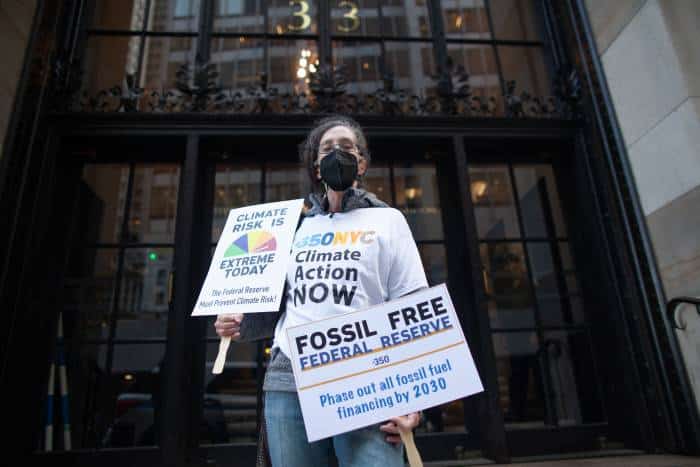On September 30, the Federal Reserve Bank of New York hosted a conference on “Financial Stability Considerations for Monetary Policy.” After the Federal Reserve’s Vice Chair of Supervision Michael Barr stated that the Fed is working to understand how climate change poses risks to banks and the financial system, activists and advocates were looking forward to hearing more about how the Fed might act to protect the stability of our economy.
According to the event’s description, “the academic consensus has evolved to recognize that financial vulnerabilities have the potential to adversely affect the real economy” so we naturally expected that the climate crisis would be part of the discussion.Our financial system faces no bigger threat than the climate crisis.
As the meeting was held, a group of dedicated activists from 350 New York and Brooklyn showed up outside the New York Fed to continue to pressure the Fed to ensure monetary policy mitigates climate risk!

However, at the conference, it seems like Claudia Buch from Bundesbank (Germany’s central bank) was the only one willing to speak out and say that central banks need to work with governments to address all aspects of how the climate crisis is impacting financial stability through climate stress tests and other tools. Otherwise, climate and its ripple effects through every aspect of the world’s economy and financial systems were completely ignored… even as the experts discussed financial vulnerability, household indebtedness, and nonbank lending, all of which are are topics directly related to climate and energy.
We have so many questions for the Federal Reserve.
One of the papers discussed at the conference concludes that “the central bank should always condition monetary policy on financial vulnerability” (page 41). We saw in the 2007 recession that rising energy prices contributed to the bursting of the housing bubble in the US.
Why, then, are we not discussing the risks associated with remaining reliant on fossil fuels? Fossil fuel extraction and transport is dangerous and expensive, making it a risky investment, and the war in Ukraine has further shown that geopolitical instability can contribute to massive price fluctuations for energy. That’s not even counting the financial vulnerability of communities in areas that even now are being decimated by climate-exacerbated disasters like hurricanes and flooding.
Another paper discussed nonbank lending, and stated that there is a direct relationship between monetary policy rates and risk-taking by nonbank lenders (insurance companies, investment banks, pension funds, etc) – all of which are major supporters of the fossil fuel industry. Shouldn’t the Fed be concerned about the impact of monetary policy on these nonbank lenders’ ability to continue to pump money into the climate crisis?
We’re glad that leadership at the Federal Reserve has finally acknowledged that it’s time to act on climate… but when are they going to move from words to action?
When will they recognize that these so-called academic topics are causing real-world harm to households, vulnerable communities, businesses, and ecosystems?
The post Federal Reserve – Why is climate not a financial stability consideration for monetary policy? appeared first on 350.


0 Commentaires